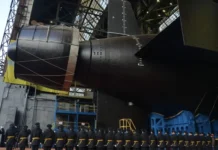
Ghost Below. By Steven Carruthers. Hardcover, 366 pages. Bluewater Press, NSW. $64.95.
Reviewed by Tom Lewis
The raid by midget submarines on Sydney Harbour has become one of the most well-known World War II military actions around Australia. It might be supposed, over the 80+ years since the night of 31 May 1942, that the many aspects of the attack have all been revealed. The new book Ghost Below by veteran author Steven Carruthers reveals that there is more to be told.
A reviewer should declare if he has a dog in the fight, and this one has two. I wrote the books Attack on Sydney Harbour, and The Secret Submarine – both are referenced in this work. (The first was about the midget submarine raid; the second about a Japanese boat I argue is sunk off NSW.) Concentrating mainly on the discovery of the third midget submarine outside the harbour in 2006, Carruthers has done an excellent job in going further than anyone else in revealing all of its final hours.
Carruthers gives plenty of background information. The Imperial Japanese Navy developed the midget submarine as part of their unique approach to submarine warfare from the 1930s. They persisted with submarine-launched aircraft where other navies had given up, and developed the midget to a level of capability unmatched by any other navy. Indeed, at the cessation of hostilities in 1945 they still had hundreds readying for combat, including suicide submarines, another Japanese innovation.
The IJN midget two-man submarine first saw combat at Pearl Harbor, with five participating in the surprise attack of December 1941. None survived, and it was doubtful whether they had inflicted any damage. Nevertheless, the Imperial Navy persisted, and as testimony to their innovative spirit, the three that attacked Sydney Harbour on 31 May 1942 had significant improvements over the Pearl Harbor model.
Japan’s attacks against Australia had started earlier with fleet submarines. Four were deployed against Darwin in January 1942 with an aim of shutting down a port which would be critically close to the Empire’s conquests and future plans. This first submarine campaign was a disaster – the 80-man I-124 remains sealed with her crew outside the northern harbour to this day. Strategically however the Japanese still wanted to proceed, and so they did with the surprise air raid of 19 February by four aircraft carriers. Utilising 188 aircraft, the attack devastated Darwin, killing 236, sinking 11 ships, and destroying 30 aircraft.
The submarine campaign which followed from mid-1942 was concentrated on the eastern coast. The midget submarine raid and the attacks by the larger fleet boats followed the failure of the Coral Sea invasion of Port Moresby. But the Japanese aim of cutting the potential base of Australia off from American use was still paramount.
Carruthers does an excellent job of describing the attack of the three midgets. His overall coverage is centred around what happened to the only one which fired its torpedoes with some success. M24 was the boat which hit HMAS Kuttabul, killing 21 sailors sleeping on board, but it missed the cruiser USS Chicago. With this midget now disappearing from the scene, another was stuck in the defensive harbour boom net, and the third depth-charged to the end by Royal Australian Navy patrol boats. M24vanished from the harbour and was not found until 2006.
Carruthers spends a lot of time revealing the story of the discovery by the local recreational group No Frills Divers. He fills in many gaps in the mystery of why the boat’s two crewmen were not picked up by the three mother submarines, which waited for several days. An expert diver and naval veteran himself, the author gives us comprehensive detail of some of the history of the underwater diving world, and the difficulties and danger of penetrating to the 60-metre depth where M24 lies now.
This is a very handsome hardback book. A colour cover shows us detail of M24’s conning tower, and that is matched by more than 20 pages containing colour illustrations inside. Numerous black-and-white pictures accompany these, while there are four appendices with illustrations finishing up the 365 pages.
After a comprehensive analysis of all aspects of the midget submarine raid, Carruthers moves to a two chapter outline of the two year program of submarine attacks centering around Australia’s east coast. This includes the torpedoing of the hospital ship Centaur off Queensland, with 268 lives lost. The narrative is well written without too much technical detail but enough to satisfy those who know something of the world of naval combat.
The author arrives at a conclusion that the M24 submariners were indeed trying to contact their mother vessel, but also that they were willing to die on the battlefield. He spends some time analysing why the submarine ended up where it did, and what its found state indicates. It is on an even keel, with the top hatch open, and the boarding ladder inside in a folded state, suggesting that the bodies of the submariners remain inside. The author gives space to all the various theories that have been raised as to the final dispositions of the crew, but is firm in his dismissal of wild theories.
There is some analysis of any suggestions to raise the submarine, and the costs and difficulties involved. Carruthers usefully brings in as a comparison the project still ongoing around the Hunley, in the USA. This boat carried out the first successful submarine combat attack in history, in the American Civil War. Submerged, in 1864 the Confederate Hunley rammed a “spar torpedo” – basically an explosive on a pole – against the side of the Union’s Housatonic off Charleston Harbor, South Carolina. The explosion sank the target vessel but also the submarine as well. It was not until 1995 that the wreck was discovered. The raising of the boat, with the remains of her eight crewmen still inside, cost Au$26m so far, and is still ongoing.
Carruthers also analyses the very necessary requirement to protect the M24 wreck. Without both legal and physical safeguards, it will be looted. He makes a useful comparison with the wreck of the collier Myola. Located in 1994 off NSW, the ship has been largely stripped of artefacts. If this sort of pillaging is not prevented, then the very object so many people want to visit disappears. The M24 wreck site is today strongly protected, and diving is by special licence only.
24 pages of endnotes and a bibliography attest to the scholarship of Ghost Below. This is a most useful addition to an important part of our military history. Highly recommended.



